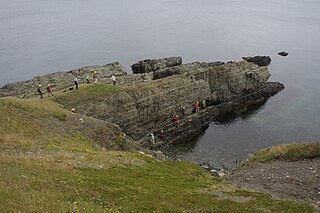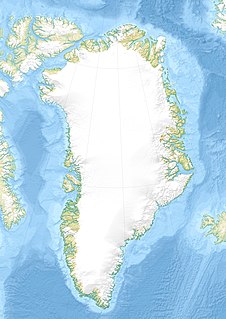
The Burgess Shale is a fossil-bearing deposit exposed in the Canadian Rockies of British Columbia, Canada. It is famous for the exceptional preservation of the soft parts of its fossils. At 508 million years old, it is one of the earliest fossil beds containing soft-part imprints.

The Cambrian Period was the first geological period of the Paleozoic Era, and of the Phanerozoic Eon. The Cambrian lasted 55.6 million years from the end of the preceding Ediacaran Period 541 million years ago (mya) to the beginning of the Ordovician Period 485.4 mya. Its subdivisions, and its base, are somewhat in flux. The period was established by Adam Sedgwick, who named it after Cambria, the Latin name of Wales, where Britain's Cambrian rocks are best exposed. The Cambrian is unique in its unusually high proportion of lagerstätte sedimentary deposits, sites of exceptional preservation where "soft" parts of organisms are preserved as well as their more resistant shells. As a result, our understanding of the Cambrian biology surpasses that of some later periods.

The Ediacaran Period is a geological period that spans 94 million years from the end of the Cryogenian Period 635 million years ago (Mya), to the beginning of the Cambrian Period 541 Mya. It marks the end of the Proterozoic Eon, and the beginning of the Phanerozoic Eon. It is named after the Ediacara Hills of South Australia.
The Precambrian is the earliest part of Earth's history, set before the current Phanerozoic Eon. The Precambrian is so named because it preceded the Cambrian, the first period of the Phanerozoic eon, which is named after Cambria, the Latinised name for Wales, where rocks from this age were first studied. The Precambrian accounts for 88% of the Earth's geologic time.

The Ellsworth Mountains are the highest mountain ranges in Antarctica, forming a 360 km (224 mi) long and 48 km (30 mi) wide chain of mountains in a north to south configuration on the western margin of the Ronne Ice Shelf in Marie Byrd Land. They are bisected by Minnesota Glacier to form the Sentinel Range to the north and the Heritage Range to the south. The former is by far the higher and more spectacular with Mount Vinson (4,892 m) constituting the highest point on the continent. Geologically, they are part of the Antarctandes which stretch from the Antarctic Peninsula to Cape Adare on the western shore of the Ross Sea. The Antarctandes form the southernmost arc of the Pacific 'Ring of Fire'. The mountains are located within the Chilean Antarctic territorial claim but outside of the Argentinian and British ones.

The Sticht Range is a mountain range located in the West Coast region of Tasmania, Australia. The range runs between two tributaries of the Eldon River and is located within the eastern part of the West Coast Range and has an unnamed peak with an elevation of 1,080 metres (3,540 ft) above sea level.
The Kaili Formation is a stratigraphic formation which was deposited during the Lower and Middle Cambrian. The formation is approximately 200 metres (660 ft) thick and was named after the city Kaili in the Guizhou province of southwest China.

Peronopsis is a genus of trilobite restricted to the Middle Cambrian. Its remains have been found in Asia, Australia, Europe, and North America.

The Wheeler Shale is a Cambrian (c. 507 Ma) fossil locality world-famous for prolific agnostid and Elrathia kingii trilobite remains and represents a Konzentrat-Lagerstätten. Varied soft bodied organisms are locally preserved, a fauna and preservation style normally associated with the more famous Burgess Shale. As such, the Wheeler Shale also represents a Konservat-Lagerstätten.
The Cambrian explosion or Cambrian radiation was an event approximately 541 million years ago in the Cambrian period when practically all major animal phyla started appearing in the fossil record. It lasted for about 13 – 25 million years and resulted in the divergence of most modern metazoan phyla. The event was accompanied by major diversification of other organisms.

The Stephen Formation is a geologic formation exposed in the Canadian Rockies of British Columbia and Alberta, on the western edge of the Western Canada Sedimentary Basin. It consists of shale, thin-bedded limestone, and siltstone that was deposited during Middle Cambrian time. It is famous for the exceptional preservation of soft-bodied fossils: the Burgess Shale biota. The formation overlies the Cathedral escarpment, a submarine cliff; consequently it is divided into two quite separate parts, the 'thin' sequence deposited in the shallower waters atop the escarpment, and the 'thick' sequence deposited in the deeper waters beyond the cliff. Because the 'thick' Stephen Formation represents a distinct lithofacies, some authors suggest it warrants its own name, and dub it the Burgess Shale Formation. The stratigraphy of the Thin Stephen Formation has not been subject to extensive study, so except where explicitly mentioned this article applies mainly to the Thick Stephen Formation.
The Lynx Formation or Lynx Group is a stratigraphic unit of Late Cambrian (Dresbachian) age in the Western Canada Sedimentary Basin. It is present in the Canadian Rockies of Alberta and British Columbia. It was originally described as the Lynx Formation by Charles Doolittle Walcott in 1913, based on and named for outcrops on the slopes of Lynx Mountain on the continental divide east of Mount Robson. It was subdivided into five formations and elevated to group status by J.D. Aitken and R.G. Greggs in 1967. The name Lynx Formation continues to be used in areas where some or all of the subdivisions cannot be distinguished. All of the formations in the Lynx Group include fossil trilobites and some contain the stromatolite Collenia.

The Terreneuvian is the lowermost and oldest series of the Cambrian geological system. Its base is defined by the first appearance datum of the trace fossil Treptichnus pedum around 541 million years ago. Its top is defined as the first appearance of trilobites in the stratigraphic record around 521 million years ago. This series was formally ratified by the International Commission on Stratigraphy in 2012.
Stage 2 of the Cambrian is the unnamed upper stage of the Terreneuvian series. It lies atop the Fortunian and below Stage 3 of the Cambrian. It is commonly referred to as the Tommotian, after the Cambrian stratigraphy of Siberia. Neither the upper nor lower boundary has yet been defined by the International Commission on Stratigraphy. The preferred definitions for the lower boundary are the first appearance of the molluscs Watsonella crosbyi or Aldanella attleborensis around 529 million years ago. The proposed upper boundary might be the first appearance of trilobites around 521 million years ago.
The Mount Whyte Formation is a stratigraphic unit that is present on the western edge of the Western Canada Sedimentary Basin in the southern Canadian Rockies and the adjacent southwestern Alberta plains. It was deposited during Middle Cambrian time and consists of shale interbedded with other siliciclastic rock types and limestones. It was named for Mount Whyte in Banff National Park by Charles Doolittle Walcott, the discoverer of the Burgess shale fossils, and it includes several genera of fossil trilobites.

The Buen Formation is a geologic formation and Lagerstätte in the north of Greenland. The shale preserves fossils dating back to the Early Cambrian period.
The Mount Simon Sandstone is the basal sandstone of the Potsdam Sandstone. It was deposited in a nearshore environment, unconformably overlying Precambrian basement.
Kallidontus is an extinct genus of conodonts.
Protohertzina is a genus of conodonts or, possibly, Chaetognaths, found at the beginning of the Cambrian explosion.
The Pika Formation is a stratigraphic unit of Middle Cambrian age that is present on the western edge of the Western Canada Sedimentary Basin in the Canadian Rockies of Alberta and British Columbia. It was named for Pika Peak near Lake Louise in Banff National Park by C.F. Deiss in 1939. It is fossiliferous and preserves several genera of trilobites. Outcrops of the Pika Formation can be seen in Banff and Jasper National Parks.









